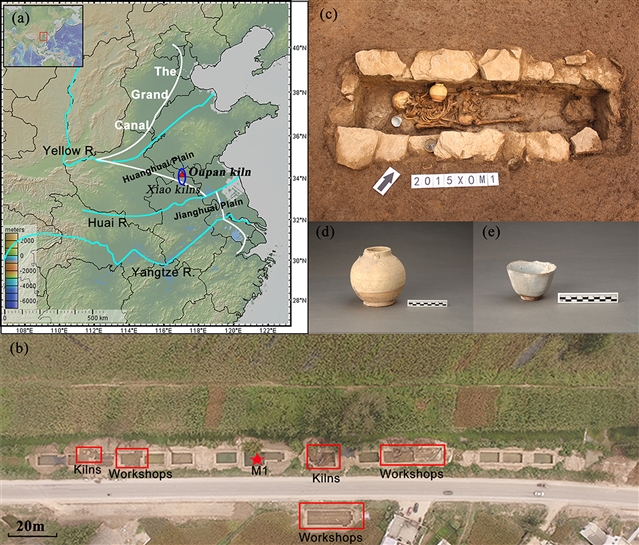|
|
| 从窑匠的身后事,窥进不一样的隋唐十二时辰 | Scientific Reports |
|
论文标题:Osteobiography of a seventh-century potter at the Oupan kiln, China by osteological and multi-isotope approach
期刊:Scientific Reports
作者:Bing Yi,Jinglei Zhang,Botao Cai,Zhongyun Zhang,Yaowu Hu
发表时间:2019/08/28
数字识别码:10.1038/s41598-019-48936-1
近年来,利用不同骨骼元素的多同位素分析重建个体生命史,已成为生物考古领域的一个活跃课题。然而,大多数此类研究关注的是社会地位高的个体,鲜有人关心社会地位低的工匠个体。在近期发表在Scientific Reports上的一项研究中,来自中国科学院古脊椎动物与古人类研究所的研究人员对中国安徽欧盘窑址出土的一具人体骨骼进行了全面的分析,以恢复其骨生物学特征。此次研究成果为考古学、历史学和人类学研究中普遍被忽视的工匠的生活史提供了一个初步的视角

图1 :a)在文本中提到主要地点位置:Oupan窑(?),萧窑的分布(○);(b)坟墓(★)及窑场及工场(□)的位置;(c)以伸直仰卧姿势埋葬的人体骨骼;(d)从坟墓取出一个黄釉的四个环耳;(e)墓中的绿釉杯。(使用软件Geo Map v 3.6.10创建地图,经瓯盘窑挖掘者(第三和第四作者)许可复制的照片。)
该考古地点的周边信息,简单的陪葬品和年代测定结果(公元534-644年)表明,这具人体骨骼可能属于隋唐早期的一名窑匠,社会等级较低;骨科学调查显示,他的脊椎异常与长期体力劳动有关;同位素数据表明他主要食用C3(小麦、豆类)/C4(小米)为主的陆地食物;牙本质切片的同位素(C, N)剖面图和骨磷灰石和牙釉质的同位素数据(C, O)表明,他在童年和成年期间经历了剧烈的饮食变化和/或几次迁移。他坎坷的人生轨迹与他的身份和低下的社会地位高度相关。
研究人员通过专业的技术手段及数据分析,为我们展示一个了“朱门酒肉”之外隋唐影像,分享了一位隋唐窑匠坎坷忙碌的一生。窑匠的遗骨吐露出的颠沛生活印证了当时制陶工艺的发展。瓯盘窑位于我国北方和南方生产白瓷和青瓷的过渡地带,生产的青瓷多,白瓷少。制作大量的绿釉瓷需要熟悉工艺流程的南方烧制工,因此在这里学习的陶工有可能是从南方招募来的,并在窑内工作了很长时间。这样的考古发现有助于验证了一些历史文献的记录,也为未来更多的类似研究提供了重要参考。
虽然记载隋唐时期历史文化信息的文献资源丰富,但历史对社会物质文明的创造者——工匠却鲜有记载。研究人员希望在今后更多地开展以人类文明奠基人和精品创造者——工匠的生活史重建为重点的类似研究,为了解历史提供一个不一样的视角。
摘要:In recent years, the reconstruction of individual life history by the multi-isotope analysis of different skeletal elements has become an active topic in bioarchaeological field. However, most studies focus on the persons with high social status and none cares for craftsmen with low social status. In this study, we undertook a comprehensive analysis on a human skeleton buried in the Oupan kiln, Anhui, China to recover his osteobiography. The archaeological context and dating result (534–644 cal. AD) indicate that he might be a potter at the kiln during the Sui and early Tang Dynasty, characteristic of low social hierarchy. The osteological investigation suggests that he had abnormal vertebrae related to long-term physical labor. In general, the isotopic data demonstrate that he mainly consumed C3(wheat, beans)/C4(millets)-based terrestrial foods. The isotopic (C, N) profiles of dentin sections and isotopic data (C, O) of bone apatite and teeth enamel indicate that he had experienced dramatic dietary changes and/or several migrations throughout the childhood and adulthood. His turbulent life trajectory was highly relevant to his identity and low social status. Our study provides a pilot insight into the life history of craftsmen who was generally overlooked in archaeological, historic and anthropological research.
(来源:科学网)
特别声明:本文转载仅仅是出于传播信息的需要,并不意味着代表本网站观点或证实其内容的真实性;如其他媒体、网站或个人从本网站转载使用,须保留本网站注明的“来源”,并自负版权等法律责任;作者如果不希望被转载或者联系转载稿费等事宜,请与我们接洽。